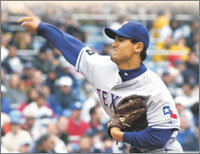Technique over Power

Two-seam Fastballs-
Most of Park Chan-hos pitches these days are two-seam fastballs. Theyre similar to sinkers in that the index and middle fingers are placed along the stitches on the ball. The two-seam fastball is 5-6km slower than the regular four-seam variety, but it travels at a similar velocity and then drops a bit approximately 1.5m in front of home plate, which makes it ideal for getting ground outs.
In fact, Park has had 25 fly outs and 32 ground outs this year, with a ground-out-to-fly-out ratio of 1.28. This is his best record since his heyday back in 1998, when the figure stood at 1.48. Parks two-seamers are tailing fastballs, so they tend to have a backspin. For lefthanded hitters, they dig into the strike zone from the inside, while for righties, what looked like outside pitches turn into strikes.
Greg Maddux (Chicago Cubs), who boasts pinpoint control, once praised Park by saying, If Park Chan-ho, who throws sinkers, can gain proper control over the two-seam fastball, he will become the best in the Major League.
Curve Balls-
Without doubt, Park Chan-hos most representative breaking ball is the curve. During his days with the L.A. Dodgers, Park commanded a cascading power curve reminiscent of Hideo Nomos (Tampa Bay Devil Rays) forkball. To throw it, the pitcher grips the outside stitch with the middle finger, firmly supports the middle of the balls underside with the thumb, then uses a snapping wrist motion.
In the Rangers game against the New York Yankees on April 24, the ball that got Jorge Posada to strike out swinging in a two-down, full-count, runners on first and second clutch situation in the six inning was this 132km/h curve. Because it also changes horizontally, arching from outside to inside, its sometimes called a backdoor curve. Another favorite of Parks is the slow curve, which hits a minimum velocity of just 119km/h.
Slurve-
A slurve is somewhere between a slider and a curve. It drops like a curve, but has a high velocity and changes from side to side. The grip is similar to a slider, except that the index and middle fingers are held slightly apart, as in the two-seam fastball. When baseball people first saw it, they called it a slider. But when Park insisted that it wasnt, they began to call it a slurve.
Parks slurve curves toward the inside of a lefthanded hitter. Its the secret behind his opposing batting average of just .220 against lefties (.243 against righties) this season.
Changeup-
When throwing a changeup, the grip itself is different, as are the amount of pressure placed on the ball and the drop in arm speed at the release point. The one thing in common is the change in velocity, which throws off a hitters timing. The circle changeup, which Park likes to use, is also called an OK ball because the grip resembles an OK sign. Its 10-15km slower than a straight ball, and also has some of the characteristics of a breaking ball that curves toward the inside.
Four-seam Fastball-
This was once Parks most decisive pitch. By crossing the index and middle fingers perpendicularly with the stitches, the pitcher grips all four of the balls seams. Although its lost some of its former power, Parks rising fastball in the Yankees game on April 24 recorded an impressive 153km/h.
The four-seamer has become almost the exclusive province of closers because of the toll it takes on the pitchers stamina, but Park has successfully filled out his comeback repertoire by commanding the four-seam fastball in addition to the two-seamer and three breaking balls.
Hwan Soo Zang zangpabo@donga.com







